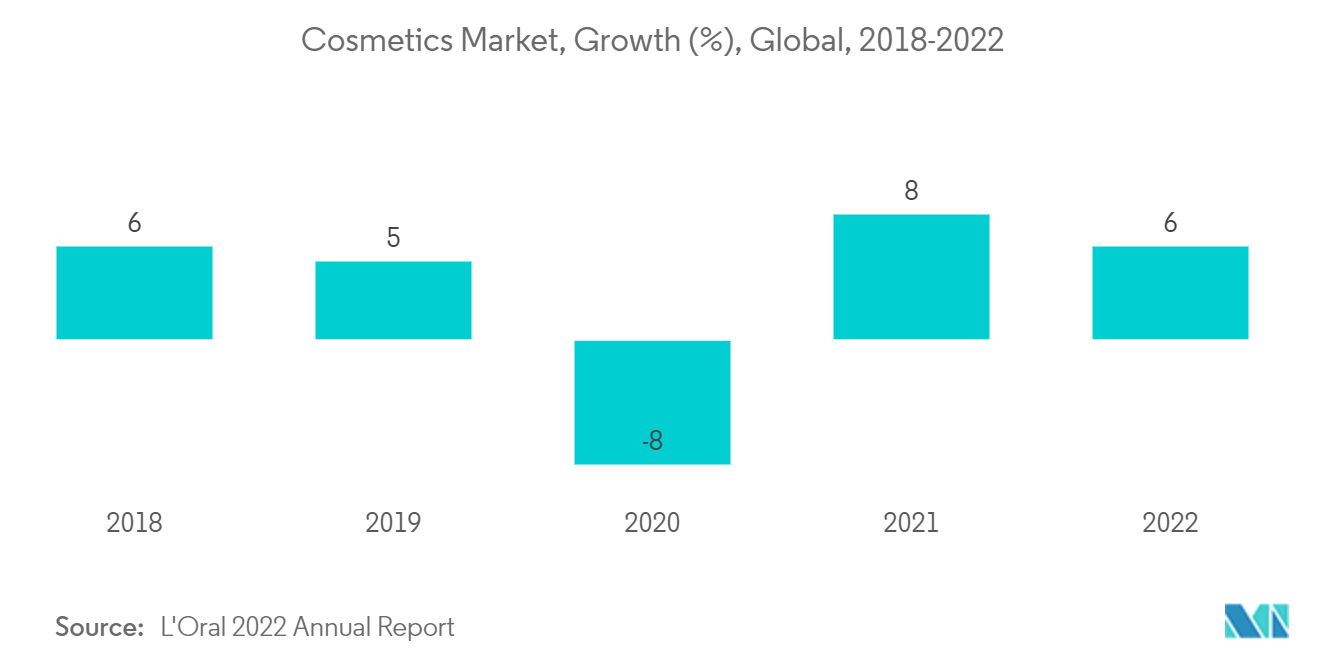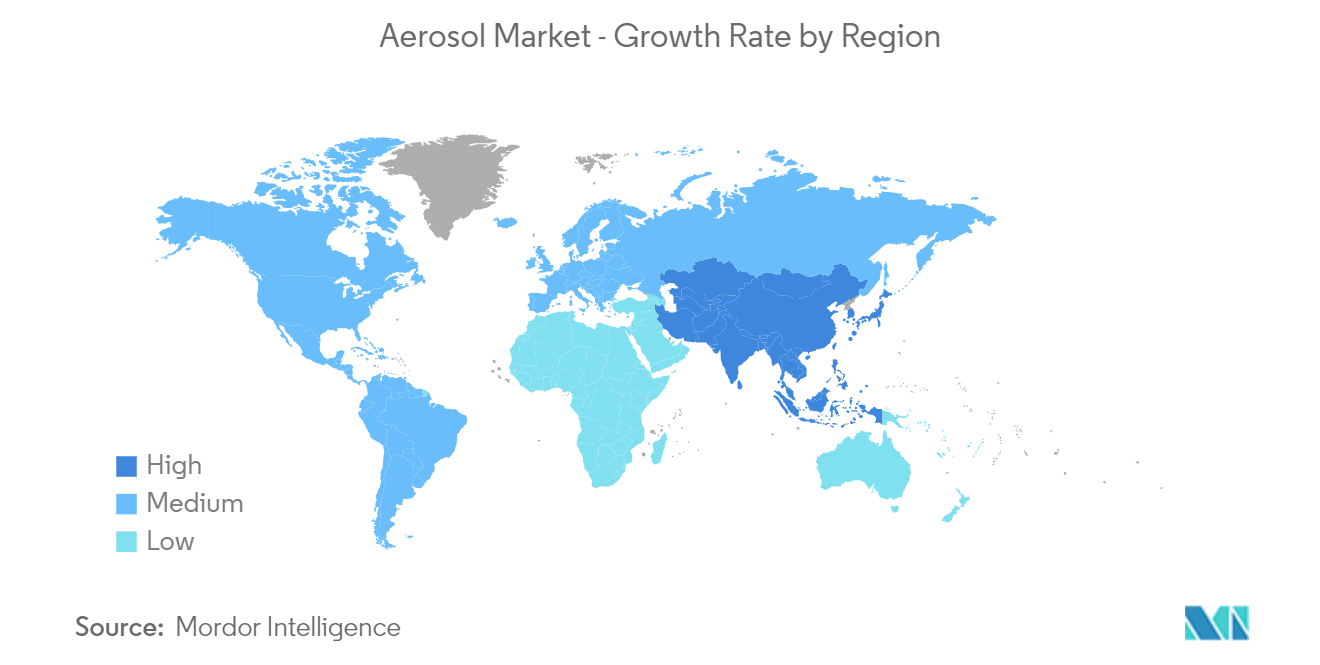Market Trends of Aerosol Industry
Personal Care Industry to Dominate the Market
- Aerosols are described scientifically as colloids of small, solid particles or liquid droplets in air or another gas. This definition encompasses man-made products and natural phenomena, such as fog. Cosmetic products, such as hair sprays, creams, foams and gels, toilette liquids, and others, are handled more practically and hygienically in the current scenario.
- Aerosol products can be applied without contact, protecting users from infections and reducing the risk of burns or lacerations. Furthermore, the sealed package prevents product contamination. As a result, the demand for aerosol has surged in the personal care market. Aerosol cans are one of the best choices for packaging across the personal care and cosmetics industry. Since aerosol cans hold high recycling rates, the demand for aerosol cans tends to rise in terms of sustainability.
- According to the reports by L’Oreal, the revenue of global beauty and personal care is anticipated to ascend to USD 784.6 billion in 2025.
- Japan is home to more than 3,000 beauty care companies, including global brands of Shiseido, Kao, Kosé, and Pola Orbis. The Japanese beauty industry is carried by a wide range of cosmetic products, with skincare and makeup being in high demand.
- According to China's National Bureau of Statistics (NBS), the cosmetics market in China grew by around 5.1% in 2023, reaching CNY 414.17 billion (~USD 58.61 billion). The Chinese beauty market is rapidly recovering after a challenging year due to economic uncertainty, pandemic policy shifts, and lockdowns. However, despite the drop in sales, there is no denying that cosmetic and beauty products continue to gain traction among Chinese consumers.
- According to the Indian Brand Equity Foundation (IBEF), the Indian beauty, cosmetic, and and grooming market will grow to USD 20 billion by 2025, driven by the increasing disposable income of the middle class and the growing desire to live well and look good.
- The North American personal care market has remained resilient over the past years. The market continues to innovate and adapt to the new demands of consumers, who want more than just quality, performance, and innovation; they want meaning in their purchases, including beauty.
- According to a study by Groupon, American women spend nearly USD 3,700 on various beauty products and services yearly, signifying the considerably high expenditure on such products.
- The United States generated the most revenue from the global beauty and personal care market in 2023, with USD 97.81 billion, followed by China, generating a revenue of USD 67.18 billion, further followed by Japan, with a revenue of USD 45.96 billion. Germany ranked first among European nations, with over USD 20 billion.
- The market for personal care products is dominated by a few key players like L’Oréal, P&G, Unilever, and Shiseidō.
- All such factors are expected to contribute to the aerosol market in the personal care industry during the forecast period.

Asia-Pacific to be the Fastest-growing Region
- Asia-Pacific is expected to witness strong growth in the demand for aerosol, driven by increasing demand for personal care products, increasing investments in the medical industry, and increasing automotive production in the region.
- In Asia-Pacific, China is expected to witness noticeable growth in the demand for aerosol during the forecast period, owing to the robust demand from the automotive industry and increasing construction and architectural projects, which is further likely to increase the demand for paints and coatings.
- According to the Hong Kong Trade Development Council, China is the world's second-largest consumer market for cosmetic products. In 2022, cosmetics sales in China increased by 14% compared to the year before, according to data from the National Bureau Of Statistics.
- According to a report by L'Oréal, the country generated USD 55.3 billion in the beauty and personal care market in 2022. The country’s beauty market witnessed a strong rebound in 2022 after facing a slowdown due to economic uncertainties, numerous lockdowns, and other pandemic policy changes.
- China consists of around 60% of the entire coatings volume of Asia-Pacific, according to the American Coatings Association. Rapid urbanization during this period has spurred the domestic paints and coating industry.
- The production and sales in Asia-Pacific are primarily dominated by countries like China, India, and Japan, which consist of large automotive manufacturers and a vast number of production bases within the countries.
- According to the China Association of Automobile Manufacturers (CAAM), China has the most significant automotive production base in the world, accounting for a total vehicle production of 30,160,966 units in 2023, registering an increase of 11.6% compared to 27,020,615 units produced last year. As per the International Trade Administration (ITA), domestic automotive production is expected to reach 35 million units by 2025.
- In China, the main focus is to increase production and sales of electric vehicles. To this end, the country has set a target to produce 7 million electric vehicles per year by 2025. By 2025, the goal is to bring electric vehicles into 20 % of total new vehicle production in China.
- According to the National Investment Promotion and Facilitation Agency (Invest India), India stands eighth in the beauty and personal care (BPC) market. Factors such as growing awareness, easier access, and changing lifestyles are driving the market. In 2023, the personal hygiene market was expected to reach USD 15 billion.
- India has become the second-largest automotive vehicle manufacturer in the region. According to Organisation Internationale des Constructeurs d'Automobiles (OICA), in 2023, Indian automotive manufacturing industry observed a growth of about 7% compared to 2022 and produced about 58,51,507 vehicles.
- The Japan Cosmetic Industry Association (JCIA) was established in April 2023 by integrating the Tokyo Cosmetic Industry Association, the Japan Cosmetic Industry Federation, the West Japan Cosmetic Industry Association, and the Chubu Cosmetic Industry Association.
- According to a report published by Kao Corporation, one of the key players in the Japanese cosmetic industry, the overall market in Japan grew by over 3% in 2022, with further growth anticipated in the next several years as the market recovers.
- Japan has over 3,000 toiletries, beauty, and personal care companies, including global brands like Shiseido, Kao, Kosé, and Pola Orbis. Furthermore, its major players are Shiseido Company, Mandom Corporation, Loreal, Procter and Gamble, and Unilever. However, shrinking demographics is highly affecting the market.
- According to Japan Automobile Manufacturers Association (JAMA), the motor vehicles production of the country in 2023 grew by 14.84% and accounted for 8,998,538 units.
- Therefore, such growth in the automotive, paints and coatings, and furniture industries is likely to increase the demand for aerosol products in the coming years, further driving the demand in the aerosol market.

